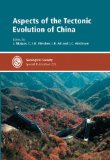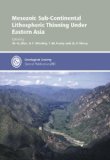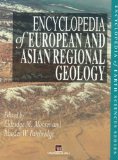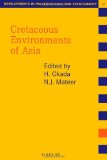Geology of Asia
- Chinese Academy of Geological Sciences
- Institute of Geology and Geophysics, Chinese Academy of Sciences
- Nanjing Institute of Geology and Palaeontology
- A multidisciplinary study on the emplacement mechanism of the Qingyang-Jiuhua Massif in Southeast China and its tectonic bearings. Part I: structural geology, AMS and paleomagnetism

- A Virtual Field Trip to the Stone Forest, Kunming, Yunnan Province
- Accretionary tectonics and sedimentation during late Paleozoic arc collision, China-Mongolia border region

- Ar/Ar Geochronology of ultrahigh-pressure metamorphism in central China

- Biostratigraphy and geography of the Ordovician-Silurian Lungmachi black shales in South China

- Chronology and petrogenesis of the Hejiazhuang granitoid pluton and its constraints on the Early Triassic tectonic evolution of the South Qinling Belt

- Contrasted tectonic styles for the Paleoproterozoic evolution of the North China Craton. Evidence for a ~2.1 Ga thermal and tectonic event in the Fuping Massif

- Cooling paths during the Mesozoic Extensional Tectonics of NE China: example from the South Liaodong Peninsula Metamorphic Core Complex

- Cratonization and the Ancient North China Continent: A summary and review

- Cretaceous - Cenozoic history of the southern Tan-Lu fault zone: Apatite fission-track and structural constraints from the Dabie Shan (eastern China)

- Detrital zircon and apatite fission track data in the Liaoxi basins: Implication to Meso-Cenozoic thermo-tectonic evolution of the northern margin of the North China Craton

- Early Paleogene stratigraphic sequences, mammalian evolution and its response to environmental changes in Erlian Basin, Inner Mongolia, China

- Effects of Sedimentary Heterogeneity on Hydrocarbon Accumulations in the Permian Ordos Basin, China: Insight From an Integrated Stratigraphic Forward and 3D Petroleum System Modelling

- Evolution of Early Triassic outer platform paleoenvironments in the Nanpanjiang Basin (South China) and their significance for the biotic recovery

- Exhumation of the ultrahigh-pressure continental crust in east-central China: Cretaceous and Cenozoic unroofing and the Tan-Lu Fault

- Exhumation of ultrahigh-pressure rocks in east-central China: Late Triassic-Early Jurassic tectonic unroofing

- Geochronology and Tectonic Evolution of the Lincang Batholith in Southwestern Yunnan, China

- Geochronology of the volcanic rocks in the Lu-Zong basin and its significance

- Geological Map of The People's Republic of China

- Geology of Tibet Plateau, the Roof of the World
- Integrated High-resolution Stratigraphy of the Doushantuo Formation, South China

- International Field Excursion and Workshop on Tectonic Evolution and Crustal Structure of the Paleozoic Chinese Tianshan

- Inversion of the Paleogene Chinese continental margin and thick-skinned deformation in the western foreland of Taiwan

- Jurassic rocks, bivalves, and depositional environments of the source area of the Yangtze River, Qinghai Province, western China

- Late Eocene sea retreat from the Tarim Basin (west China) and concomitant Asian paleoenvironmental change

- Late Mesozoic compressional to extensional tectonics in the Yiwulüshan massif, NE China and its bearing on the evolution of the Yinshan-Yanshan orogenic belt: Part I: Structural analyses and geochronological constraints

- Late Palaeozoic–Early Mesozoic geological features of South China:
Response to the Indosinian collision events in Southeast Asia

- Magnetostratigraphic Age and Boundaries of the Yushe Formation

- Mesozoic and Cenozoic tectonic history of the central Chinese Tian Shan: Reactivated tectonic structures and active deformation

- Mesozoic Extensional Tectonics in Eastern Asia: The South Liaodong Peninsula Metamorphic Core Complex (NE China)

- Mesozoic Tectonic Dynamics and Chronology in the Eastern North China Block

- Metamorphic Core Complex dynamics and structural development: Field evidences from the Liaodong Peninsula (China, East Asia)

- Neogene uplift of the Tian Shan Mountains observed in the magnetic record of the Jingou River section (northwest China)

- New age constraints on the metamorphic evolution of the high-pressure/low-temperature belt in the western Tianshan Mountains, NW China

- Onset of the Kwangsian Orogeny as evidenced by biofacies and lithofacies

- Palaeozoic collision between the North and South China Blocks, Triassic intracontinental tectonics, and the problem of the ultrahigh-pressure metamorphism

- Palaeontology and biostratigraphy of the Lower Cretaceous Qihulin Formation in eastern Heilongjiang, northeastern China

- Paleogene-Neogene stratigraphic realm and sedimentary sequence of the Qinghai-Tibet Plateau and their response to uplift of the plateau

- Paleozoic metamorphism in the Qinling orogenic belt, Tongbai Mountains, central China

- Permian-Triassic amalgamation of Asia: Insights from Northeast China sutures and their place in the final collision of North China and Siberia

- Petrogenesis of Mesozoic granitoids and volcanic rocks in South China: A response to tectonic evolution

- Polyorogenic evolution of the Paleoproterozoic Trans-North China Belt — New insights from the Lüliangshan-Hengshan-Wutaishan and Fuping massifs

- Precambrian-Cambrian biosphere (r)evolution: Insights from the Chinese Yangtze Platform

- Qinling-Dabie ultrahigh-pressure collisional orogen

- Research On Tectono-thermal Evolution Modeling Method For Superimposed Basin With The Jianghan Basin As An Example

- Sedimentary Basins of the Late Mesozoic Extensional Domain of China and Mongolia

- Sedimentary geochemistry and provenance of the Lower and Middle Devonian Laojunshan Formation, the North Qilian Orogenic Belt

- Sedimentary processes, evolution, and paleoenvironmental reconstruction of the southern margin of the Ediacaran Yangtze platform (Doushantuo Formation, central China)

- SHRIMP zircon U-Pb age constraints on Neoproterozoic Quruqtagh diamictites in NW China

- South China Block-Indochina collision: where, when, and how?

- Stratigraphic thermohistory and its implications for regional geo-evolution in the Tarim Basin, NW China

- Stratigraphy, Sedimentary Structures, and Textures of the Late Neoproterozoic Doushantuo Cap Carbonate in South China

- Syn-collisional channel flow and exhumation of paleoproterozoic High Pressure rocks in the Trans-North China Orogen: the critical role of partial-melting and orogenic bending

- Tectonic implications of Late Paleozoic stratigraphic distribution in Northeast China and adjacent region

- Tectonics of the Qinling (central China): Tectonostratigraphy, geochronology, and deformation history

- Tibet: A Virtual Field Trip
- Timing, duration and role of magmatism in wide rift systems: Insights from the Jiaodong Peninsula (China, East Asia)

- Upper Jurassic and lower cretaceous of Sanjiang-Middle Amur basin: Non-marine and marine correlation

- China Petroleum Material & Equipment Corporation
- Crude-oil hydrocarbon composition characteristics and oil viscosity prediction in the northern Songliao Basin

- Depositional environment of terrestrial petroleum source rocks and geochemical indicators in the Songliao Basin

- Diagenetic fluids evolution and genetic mechanism of tight sandstone gas reservoirs in Upper Triassic Xujiahe Formation in Sichuan Basin, China

- Discovery of “Enveloping Surface of Oil and Gas Overpressure Migration” in the Songliao Basin and its bearings on hydrocarbon migration and accumulation mechanisms

- Distinct sedimentary environments and their influences on carbonate reservoir evolution of the Lianglitag Formation in the Tarim Basin, Northwest China

- Formation and accumulation of oil and gas in marine carbonate sequences in Chinese sedimentary basins

- Formation and influencing factors of carbonate source rock of the Lower Permian Chihsia Formation in Chaohu region, Anhui Province

- Geologic characteristics, controlling factors and hydrocarbon accumulation mechanisms of China’s Large Gas Provinces of low porosity and permeability

- Hydrocarbon accumulation mechanism and structure of largescale volcanic weathering crust of the Carboniferous in northern Xinjiang, China

- Hydrogen isotope composition of natural gases from the Tarim Basin and its indication of depositional environments of the source rocks

- Process and mechanism for oil and gas accumulation, adjustment and reconstruction in Puguang Gas Field, Northeast Sichuan Basin, China

- Significant carbon isotope excursions in the Cambrian and their implications for global correlations

China
Petroleum geology of China
Books about geology of China
Aspects of the Tectonic Evolution of China |
|
| Mesozoic Sub-Continental Lithospheric Thinning under Eastern Asia The North China craton is the only known place where an Archaean craton with a thick tectospheric root lost half of that root in younger tectonism by processes such as delamination, convection, hydration-weakening, compositional change or some other mechanism. In this volume, authors provide data constraining the geometry and timing of root loss, aimed at understanding why and how continental roots are lost in general. Modelling how often this process may have occurred in the geological past, and how much lithospheric material has been recycled to the convecting mantle through this mechanism, could drastically change our current understanding of crustal growth rates and processes. Possible triggering mechanisms for root loss include collision of the South China (Yangtze) and North China cratons in the Triassic, the India-Asia collision, closure of the Solonker and Monhgol-Okhotsk oceans, Mesozoic subduction of the Pacific Plate beneath eastern China, impingement of mantle plumes, mantle hydration from long-term subduction and several rifting events. In this volume, we link studies of crustal tectonics with investigations aimed at determining the nature of and timing of the formation and loss of the root, in order to better-understand mechanisms of continental root formation, evolution and recycling/removal. |
|
| Encyclopedia of European and Asian Regional Geology This unique volume, organized alphabetically by country, provides a current overview of the general geology of Europe and Asia, excluding the Arab countries and Israel. Articles primarily contain information about the stratigraphy, structure, tectonics and natural resources of each country, as well as a history of geological exploration and other issues unique to each country. Additional articles cover international subjects such as Europe, Asia, the Alps, Caucasus, Himalayas and Tien Shan mountains. Many articles are new syntheses, e.g. those on Iceland, Burma and the Philippines; some are first-time descriptions in English, e.g. those on Estonia, Moldova, Bosnia and Turkmenistan; others are published for the first time ever in any language e.g. those articles on Italy, Korea and Vietnam. Each entry is typically written by a native geologist or a geologist with extensive experience in the region, and entries include representative figures illustrating main geologic features and a selected bibliography of relevant publications generally accessible in libraries. Articles are written assuming some general geological background. The Encyclopedia will serve as a valuable source book for libraries, and will be a key reference for academic and professional personnel in industrial exploration firms and governmental agencies, as well as for university students. |
|
| Cretaceous Environments of Asia This book presents a synthesis of the principal environmental characteristics of the Cretaceous in East and South Asia. The research was accomplished under IGCP project 350, which deals with the biological, climatological and physical environments of this region during the Cretaceous. This synthesis discusses aspects of stratigraphy, sedimentology, paleontology, geochemistry, tectonics, petrology, mineralogy, and geophysics. The research results are summarised by country, and include Far East Russia, Mongolia, eastern China, Korea, Japan, Philippines, Vietnam, Laos, Cambodia, Thailand, and India. Although these countries do not encompass the entire region, this coverage provides an excellent perspective of the evolution of the region during the Cretaceous. The records incorporated in this book present a wealth of marine and nonmarine data on climate, biotic diversity, circulation and chemistry of the ocean as well as fundamental plume tectonism. The latter appears to have caused much of the environmental change in this broad region, including both an enhanced greenhouse effect and high sea levels. |
|
| Geological Formation Names of China (1866-2000) Geological Formation Names of China (1866—2000) is the only catalogue on stratigraphic nomenclature for China in the world to keep two writing types (Wade-Giles Romanization and Chinese Phonetic Alphabet) so as to provide convenience for domestic and overseas readers. The catalogue is intended for specialists and graduates in Geosciences and Stratigraphy. Shouxin Zhang (1927 —2006) was stratigrapher and research professor at the Institute of Geology and Geophysics, Chinese Academy of Sciences. |




